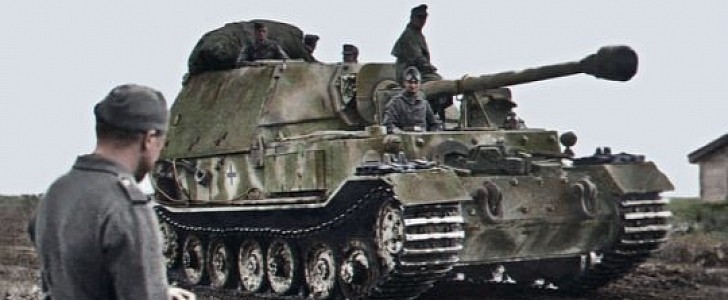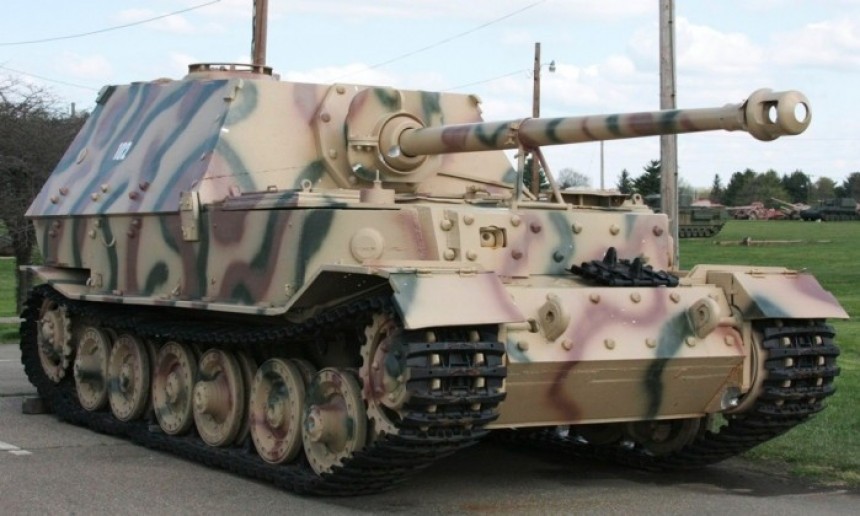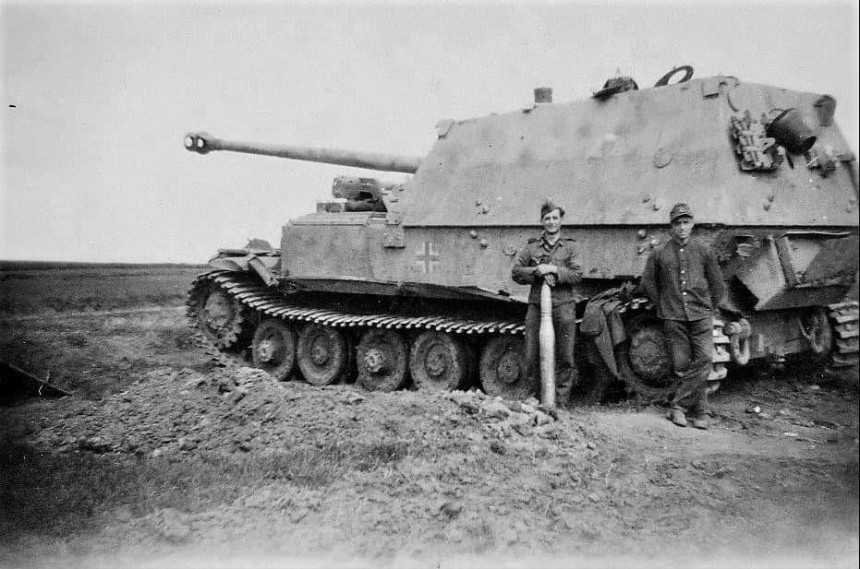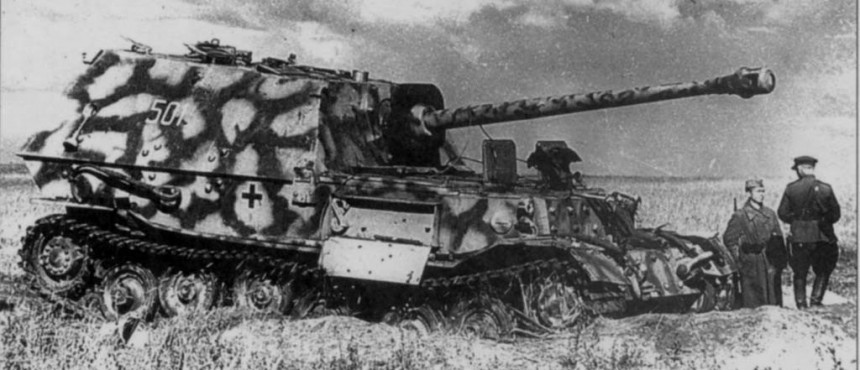Folks tend to focus on the successes of Ferdinand Porsche that manifested after his death in 1951. We're talking the 911, the Boxster, and even the electric Taycan, and rightfully so.
But don't get it twisted. A not-insignificant portion of Porsche's experience didn't come from making sports cars. Instead, the man who fathered the Beetle spent time in the 1930s and 40s as an engineer in the German Wehrmacht. Perhaps the Elefant tank is the most bonkers of all the machines he designed. It was a 143,000 pound (64,864 kg) leviathan with twin diesel engines and the main cannon that stuck out several feet past the hull.
It all sounds pretty sweet on paper, but then again, having an air-cooled engine in a 911 like a Beetle for 40 years also sounded like a good idea to someone surely. In terms of some of the more successful designs penned by Ferdinand Porsche, the Elefant was an epic fail. One that we'd understand if Porsche was keen to mention as little as possible today.
Tank warfare doctrine was still a developing field in the first years of the Second World War. There was much debate between the Allied and Axis powers about what armor, weaponry, and what overall tank size would have the ultimate advantage on a potential battlefield.
The German response to this problem was ostensibly to throw stuff on a wall and see what stuck. From the puny Panzer III to the short but powerful Jagdpanzer IV and the Gargantuan Tiger II, Germany was well suited to the experiment of finding which tank design was superior. This grand test was the crucible by which the Elefant was born, originally under the name "Ferdinand."
Meanwhile, Ferdinand Porsche was undergoing a bit of a transformation of his own. Porsche started his career designing high-quality automobiles for Germany's elite. Including working under his eventual rivals at Mercedes-Benz for a period. But the swift tides of history soon found the German-Bohemian engineer forced into a much more forceful role.
One as a right-hand man of the Wermacht. Whether Ferdinand Porsche was aware of what the German government had planned for its factory labor force or not has become a topic of some debate. Especially in the years after his death, it's a matter Porsche themselves have investigated as recently as the late 2000s. Still, it's commonly believed that he was nearly as skilled in designing tanks as he was designing cars, unless you're talking to a Russian, of course.
As far as the Elefant is concerned, at the very least, it didn't quite turn out as planned. In early 40s Germany, total war conditions merited that military manufacturers shared designs with competing companies to maximize total production and minimize costs. In the case of the Elefant, its underpinnings had their roots in the competition for the Tiger I. A design for which Porsche and its rival in the Henschel Company fielded prototypes.
To Old Man Porsche's dismay, Henschel would win the contract for full-scale production. But he'd recoup some of his losses by creating something entirely different. Not a tank, but a heavy tank destroyer. One with two 592 horsepower air-cooled Maybach diesel engines and an 88mm "Panzerjagerkanone" main cannon to punch through the armor of any Soviet T-34 or American Sherman.
It sounded fantastic in theory, but a decisive battle was needed to test whether Ferdinand Porsche's brainchild was useful. The largest tank battle the world has ever seen would serve that purpose well. The Battle of Kursk between the Germans and the Soviets was like something out of a Hollywood blockbuster. With tanks lined up in their thousands on either side of a 2,000 kilometer (1,200 mi) battlefront.
On the Russian side, Soviet Field Marshall Georgy Zhukov was informed of a never-before-seen enemy vehicle. One that dwarfed much of the tanks of the Soviet Army. But Zukhov was not intimidated by the new threat. Instead, he was sure that tactics would see the Elefant neutralized.
He planned to do this by having hoards of soldiers engage German foot-infantry in a manner that separated them from their armored vehicle support. Once isolated, the heavy and cumbersome tank destroyer was easy fodder for Soviet anti-tank rifles and cannon fire from T-34s.
It's believed that as many as 20 Elefants were put out of commission at Kursk. Some by being doused in a hail of Molotov cocktails until its treads melted and the paint peeled off the heavy steel body. It was a brutal and bloody battle, one where a quarter of a million Soviet soldiers are believed to have died. Even so, the German Army was unable to capture the city of Kursk, and the Elefant proved to be pretty much useless against the never-ending waves of Soviet troops and tanks.
The Elefant was never again fielded in such large numbers. Records indicate it did serve in areas other than the Eastern Front, including Italy, and the decisive Battle of Berlin in April 1945. Today, only two Elefant tanks survive on opposite sides of the world. One is on display at the Kubinka Tank Museum outside Moscow. Another is part of the United States Army Ordnance Training Support Facility's historic tank collection at Fort Lee, Virginia.
Whether those in charge of Porsche today would care to acknowledge the Elefant's existence today or not, it is indeed a legitimate piece of Porsche history. Without the experienced Porsche gained in his time with the Wermacht, the Cayenne, Taycan, and beloved 911 may never have graced us with their existence. Stick around for more from Porsche month right here on autoevolution.
It all sounds pretty sweet on paper, but then again, having an air-cooled engine in a 911 like a Beetle for 40 years also sounded like a good idea to someone surely. In terms of some of the more successful designs penned by Ferdinand Porsche, the Elefant was an epic fail. One that we'd understand if Porsche was keen to mention as little as possible today.
Tank warfare doctrine was still a developing field in the first years of the Second World War. There was much debate between the Allied and Axis powers about what armor, weaponry, and what overall tank size would have the ultimate advantage on a potential battlefield.
Meanwhile, Ferdinand Porsche was undergoing a bit of a transformation of his own. Porsche started his career designing high-quality automobiles for Germany's elite. Including working under his eventual rivals at Mercedes-Benz for a period. But the swift tides of history soon found the German-Bohemian engineer forced into a much more forceful role.
One as a right-hand man of the Wermacht. Whether Ferdinand Porsche was aware of what the German government had planned for its factory labor force or not has become a topic of some debate. Especially in the years after his death, it's a matter Porsche themselves have investigated as recently as the late 2000s. Still, it's commonly believed that he was nearly as skilled in designing tanks as he was designing cars, unless you're talking to a Russian, of course.
As far as the Elefant is concerned, at the very least, it didn't quite turn out as planned. In early 40s Germany, total war conditions merited that military manufacturers shared designs with competing companies to maximize total production and minimize costs. In the case of the Elefant, its underpinnings had their roots in the competition for the Tiger I. A design for which Porsche and its rival in the Henschel Company fielded prototypes.
It sounded fantastic in theory, but a decisive battle was needed to test whether Ferdinand Porsche's brainchild was useful. The largest tank battle the world has ever seen would serve that purpose well. The Battle of Kursk between the Germans and the Soviets was like something out of a Hollywood blockbuster. With tanks lined up in their thousands on either side of a 2,000 kilometer (1,200 mi) battlefront.
On the Russian side, Soviet Field Marshall Georgy Zhukov was informed of a never-before-seen enemy vehicle. One that dwarfed much of the tanks of the Soviet Army. But Zukhov was not intimidated by the new threat. Instead, he was sure that tactics would see the Elefant neutralized.
He planned to do this by having hoards of soldiers engage German foot-infantry in a manner that separated them from their armored vehicle support. Once isolated, the heavy and cumbersome tank destroyer was easy fodder for Soviet anti-tank rifles and cannon fire from T-34s.
The Elefant was never again fielded in such large numbers. Records indicate it did serve in areas other than the Eastern Front, including Italy, and the decisive Battle of Berlin in April 1945. Today, only two Elefant tanks survive on opposite sides of the world. One is on display at the Kubinka Tank Museum outside Moscow. Another is part of the United States Army Ordnance Training Support Facility's historic tank collection at Fort Lee, Virginia.
Whether those in charge of Porsche today would care to acknowledge the Elefant's existence today or not, it is indeed a legitimate piece of Porsche history. Without the experienced Porsche gained in his time with the Wermacht, the Cayenne, Taycan, and beloved 911 may never have graced us with their existence. Stick around for more from Porsche month right here on autoevolution.











